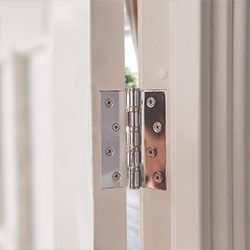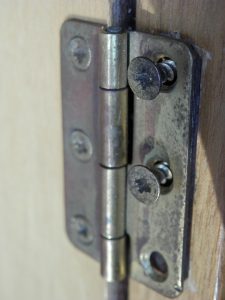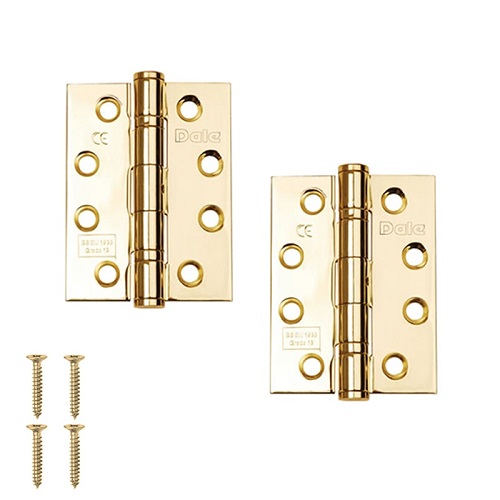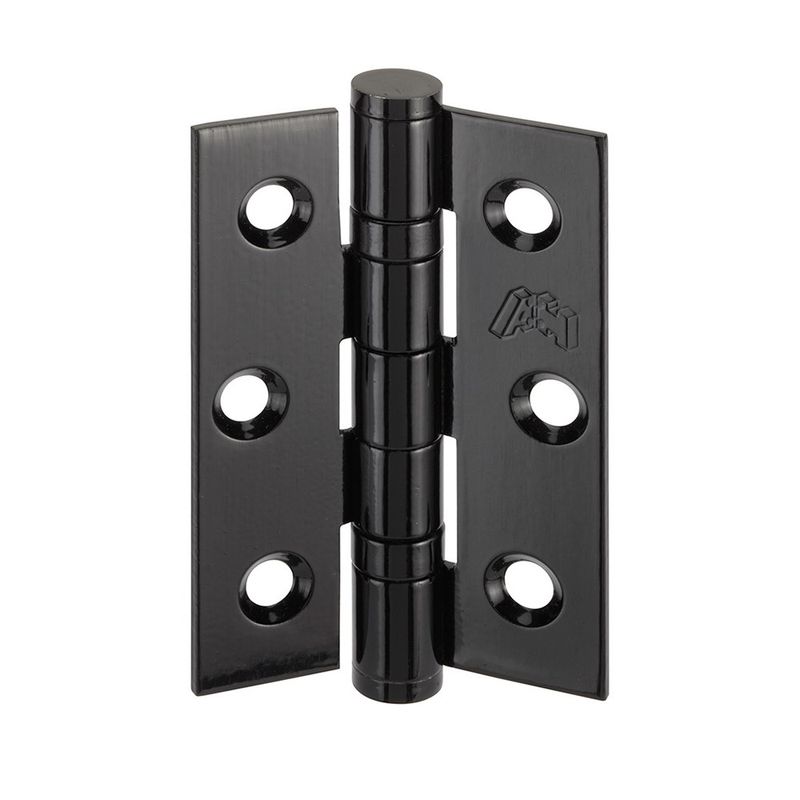Are your door hinges worn out, squeaky or past their use-by date?
Let’s face it:
Shopping for new hinges or trying to maintain your old ones can be a bit of a bother. So, chances are, you have a few questions about them, right?
The good news is:
You’ve come to the right place! We dug deep to answer the most common questions about door hinges that frequently pop up.
Here’s what we have in store for you in our hinges guide.
Table of contents:
- What is a hinge?
- How do you choose hinges for a door?
- How do I know what size hinge I need?
- How many hinges per door do I need?
- Where to put hinges on a door?
- How to stop door hinges from squeaking?
- How to adjust uPVC door hinges?
- Choosing the right door hinges and looking after them
What is a hinge, and how does a hinge work?

Let’s start at the beginning:
A hinge is a piece of mechanical hardware which connects a door or any swinging part to a frame, allowing it to turn. A door hinge is essential when fitting a door, whether it’s an internal or external one.
There is a wide range of door hinges types, including barrel hinges, butt hinges, case hinges, Parliament hinges and more that can be made from various materials and movable parts.
How do you choose hinges for a door?
So, with so many different types, how do I know which hinge to use for my next project?
Firstly, it’s important to consider the type of door (internal or external). While many hinges are suitable for both, some can be used as internal door hinges or external door hinges only. As a rule of thumb, it’s best to go with stainless steel hinges on external doors to ensure greater durability and protection from the elements.
Secondly, check what material your door is made from (wood, concrete metal or composite). For instance, weld-on hinges work great with metal doors, whereas screw-type hinges are a better option for most other materials.
Thirdly, take into account the weight of your door. If your door is heavy and ornamental, for example, brass hinges won’t be able to support it.
Now that we’ve considered these factors, let’s take a closer look at the different types of door hinges.

Types of door hinges
Butt hinge
The butt hinge is one of the most widespread types of door hinges in the UK. Keep in mind these hinges are fairly lightweight, meaning they can’t really support heavy doors. Head over to our guide on what is a butt hinge to find out more about them.
Self-closing hinge
Also called a spring hinge, a self-closing hinge enables the door to shut automatically without slamming. These work great with external doors as well as internal glass doors where a sudden draught may result in shattered glass all over your floor.
Barrel hinge
Also known as a 180-degree hinge, this popular type contains a hollow cylinder (barrel) and a pivot. Barrel hinges are highly versatile.
Parliament hinge
If you’re looking to enhance your décor, this elegant type of barrel hinge can be a great asset.
Stop hinge
As the name suggests, this hinge stops the door from opening all the way, allowing for limited movement.
How do I know what size hinge I need?
Right. You’ve now narrowed your hinge preference considerably.
But what about size? How to measure a door hinge in the UK?
Here’s the deal:
The hinge size you need depends on the size and weight of your door. So, if you’re replacing old, worn-out hinges on doors, simply remove the middle one using a screwdriver and place it open on a table.
Then, use your measuring tape to determine the height and width or the size of the corner radius if the hinge isn’t square. That’s that settled!
Bear in mind that the standard door hinge size in the UK is 76mm x 50mm.
How many hinges per door do I need?

As with door hinge sizes, the number of hinges you’re going to need ultimately depends on the size of your door. Most domestic doors, which tend to be between 60″ and 90″ in height, will require three. However, you can fit lighter internal doors less than 60″ in height with only two hinges.
In contrast, bigger doors between 90″ and 120″ tall will need four hinges. Additionally, fire doors, which are considerably heavier, must be fitted with three fire certified hinges of 4″ each as per the Fire Regulations.
Door Superstore pro tip:
In general, it’s a good idea to fit an additional hinge even to lighter doors, as it will provide extra strength, help reduce tension and minimise wear and tear – especially if the door in question sees a lot of traffic.
Where to put hinges on a door?

Typically, you’ll need to install hinges at a distance of 10″ from the bottom and 5″ from the top of the door. If you’re going with three, the third hinge will naturally go halfway between the top and bottom ones.
Now:
Fitting hinges on a door is a fairly straightforward process. To get a clearer idea of what it entails, you can check out our in-depth guide on how to fit a butt hinge for a step-by-step overview and pro tips.
How to stop door hinges from squeaking?
A squeaky door can be incredibly annoying and quickly gets on your nerves. Luckily, this is one issue that’s pretty quick and easy to deal with.
Squeaky hinges are usually old and greasy, meaning you have to clean them first.
Here’s how to clean door hinges:
First, remove the hinge pin. Then, remove the hinges from the door by unscrewing them and placing them and the pin in a vessel full of warm dishwashing soap water. After about half an hour of soaking, take them out, scrub them thoroughly and dry them with some kitchen roll.
Once you’re done cleaning the hinges, it’s time to lubricate them. The best lubricants you can use are silicone spray and lithium grease, and they’re widely available in most DIY stores. Both are excellent, long-term solutions.
Don’t have either of these at the moment?
No need to fear – either a bar of soap or olive oil will get the job done. You can even use hairspray as a short-term solution since the polymers it contains will create a seal around the hinge.

Have you tried cleaning and lubricating your hinges but found them still a bit squeaky?
This may be the reason why:
On some occasions, especially when dealing with older barrel hinges, squeaking may be caused by individual parts being out of position and rubbing against each other when you open and close the door. If that’s the case, you can take out the pin, close the door and use the pin and a hammer to gently knock them back into position.
How to adjust uPVC door hinges?
Do you have some top hinge, mortice or inset and backset issues?
Then you might have to adjust your door hinges.
There are several ways to do so, such as tightening the top hinge or replacing the screws with longer ones. Check out our extensive guide on how to adjust door hinges to find out more.
Choosing the right door hinges and looking after them
And there you have it:
The answers to all the questions about the different types of door hinges you’ve been meaning to ask.
The bottom line is:
It’s absolutely crucial to choose the right size, type and material when buying replacement hinges to avoid serious structural damage to your door and door frame.
Provided you then install and maintain them carefully, you won’t have to worry about any recurring issues such as a squeaky door or a warped door frame.


















